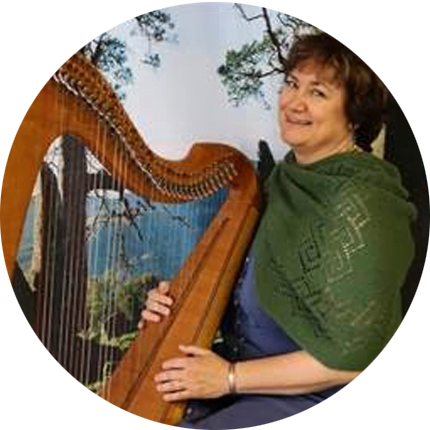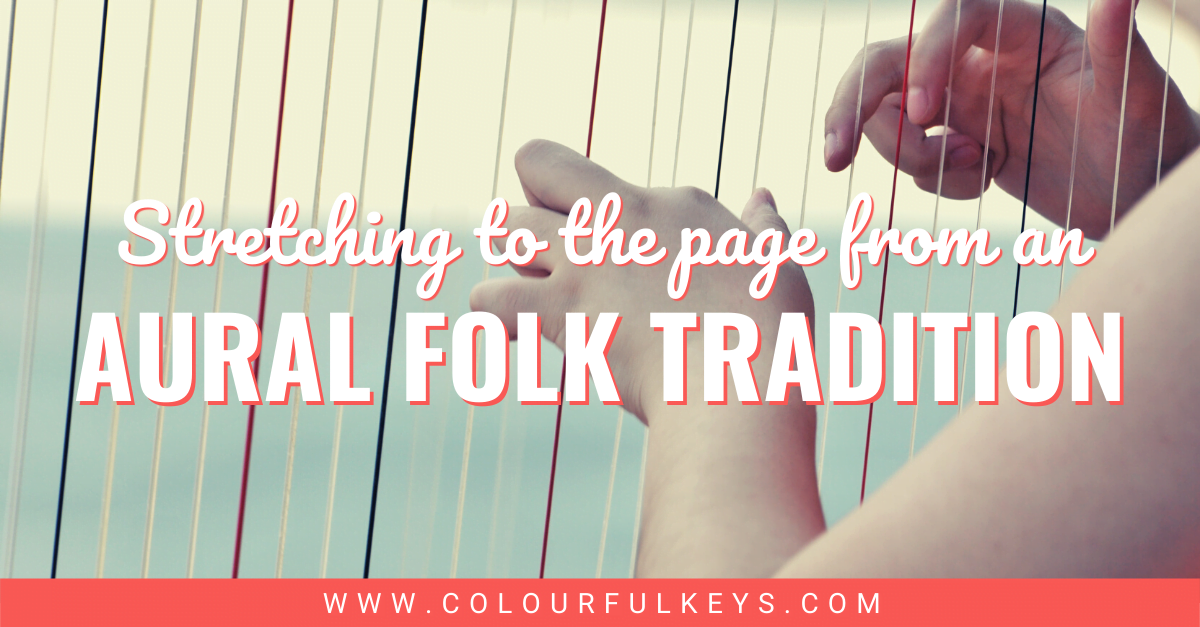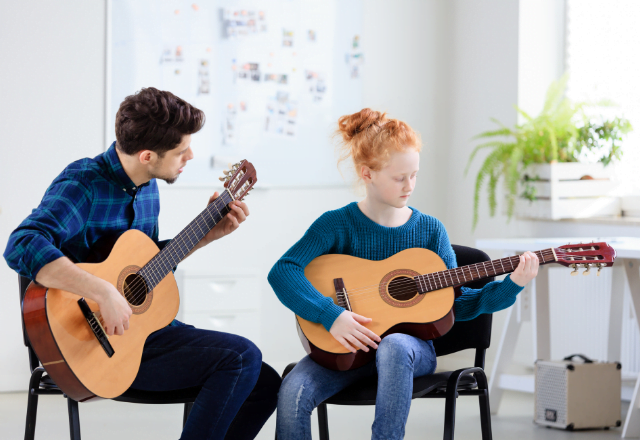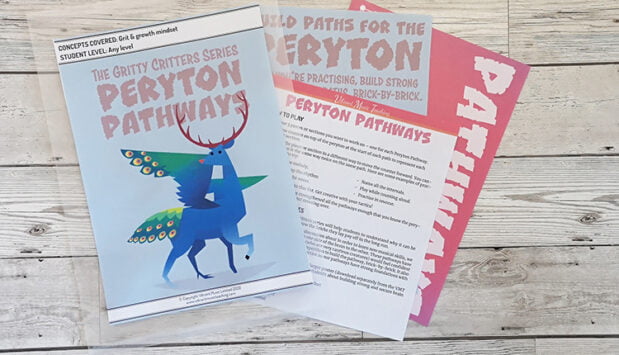
This blog post about teaching trad musicians to read music was written by Dr. Jen Narkevicius, CMP, CME. Jen is a harper in Virginia, USA. Her innovative teaching combines expertise in psychology, gifted and talented education, and ergonomics. She is a Certified Music Practitioner and Certified Music Ergonomist as well as President and Competition Committee Chair of Scottish Harp Society of America, Secretary of National Standards Board for Music Ergonomics, and instructor at Ohio Scottish Arts School. She blogs weekly at www.jeniuscreations.com.
As a trad (traditional) musician, I focus on folk music from Scotland and Ireland and I typically learn and teach tunes in the traditional way – by ear. It’s a rich way to internalise tunes while also learning about the idiom, the tradition and the culture from which it comes. But for trad students, it can be a stretch to move from teaching through this aural tradition to reading music.

There are literally millions of tunes in the world – from every culture, from each tradition and from every slice of time. Many of these tunes are no longer played, so it’s impossible to learn them aurally.
While loads of tunes have been lost over time, oh-so-many have been written down and saved for musicians to discover and share later.
Conveniently, our current system of music notation is a tool that can be applied to all the genres (orchestral, pop, jazz, folk, etc.) which makes music easy to share.
Reading is Reading
Music is a series of symbols and patterns, just like language. Written music provides another means of examining those patterns.
But learning a new language can be daunting. There aren’t many students who list English or French as their favourite subject in school!
The good news is that written music is just like any other written language: It’s a collection of lines, squiggles, and ink blots used to convey meaning which is then expressed through sound. It’s just easier to learn to read if you already speak the language.
Music scores are written in a language our students are learning to speak, and it’s our happy chance to help them become both fluent and literate.
We learn to read music much like we learnt to read words. And by following a similar process, it can be fairly painless. (Although, depending on your instrument, you may put the steps in a different order.)
There’s no magic in transitioning from aural to written music: Start with the basics and build from there.
Note: Depending on your instrument, you might do these steps in a different order.
Step 1: The Basics of Sound
We start with building fluency. In my trad music studio, I do loads of teaching by rote before we even talk about reading – even with students who already know how to read music. Because no matter how well you can read, isn’t the point to play the instrument?
So, we start there.
Beginning with teaching music by rote (even for trad students who are professional musicians on other instruments) allows us to focus on both playing the instrument and learning how to produce good sounds.
Once the student has learnt enough about the technical elements of playing to play proficiently, then we begin to learn to read.
The process continues by focussing on the role of written music as a guide, communication tool and memory aid rather than as the be-all, end-all arbiter of truth.
Step 2: Associating Notes with Names
Once students are proficient enough to navigate their way around the instrument, we learn the letter names and octaves of the strings (or keys, valves etc.)

In my harp studio, we drill by pointing to the string and naming it. When we need silly time, we give them actual words for names (apple, boy, cat etc.)
Over time, we strengthen the note names through games and races.
Step 3: Learning Tunes by Note Names
Once that is solid, we move from learning tunes by the shapes and patterns they make on the instrument to learning tunes by note names.
To do this, we switch back and forth between the 2 methods. For example, “Place the thumb on the red string” alternates with “Place your 1 on C.”
We also strengthen the note names associated with each octave by playing “Same and Different”. This is when I’ll play a note and the student either plays the same back (we both play A4) or a different octave back (I play A4, they play A2.)
As trad music students become more comfortable with thinking of the strings (keys, etc.) by their names, I move into teaching tunes by saying those letter names aloud as they’re played.
By now, students are also becoming more proficient in their playing. This means they have more capacity for adding this oral task to their auditory and visual learning.
I like to specifically discuss how hard it is to do all those things while their brains try to keep up. That makes it less likely that they’ll get discouraged by mistakes (although this is only semi-successful with the speed demons!).
Step 4: Translating Names to the Staff
When students have become comfortable with accurately naming strings (and their sounds,) we then turn to associating those sounds and the names to the ink squiggles on the page.
With the harp, we focus on the note names leaving rhythm information for later, but for piano you may focus on intervals and other instruments may use another method entirely.
With string instruments like the harp, students might go from sound to ink following a process like this:
- Point to the string
- Play the note
- Say the letter name aloud
- Point to where the note should be on the staff
- Move on to the next note
Once that becomes less of a guessing game, I have my students translate the other way:
- Point to the note on the staff
- Say the name of the note aloud
- Point to the string (in the correct octave!)
- Play the note
- Move on to the next note
Step 5: Add Written Rhythm
When students are no longer overwhelmed with the note names and location on the instrument, it’s time to introduce rhythm elements. (Again, different instruments may follow these steps in a different order.)
I like to start with pre-primary folk tunes. We take it slowly and carefully, working vocally, aurally and with the page.
A great way to work on rhythm on the page without the distraction of the staff is with Nicola’s Rhythm Vocab cards, which help students learn to recognise common rhythmic patterns before encountering them in their music.

Subscribe to the newsletter and get the RHYTHM VOCAB SAMPLE CARDS.
Enter your details to subscribe to the newsletter for piano teachers with information, tips and offers.
I hate spam as much as you do! I will only send you emails related directly to piano teaching and you can unsubscribe at any time.
If you’re part of the Vibrant Music Teaching membership, you can access the full sets of cards for all 4 levels of Rhythm Vocab in the VMT Library. If you’ve been meaning to sign up, are still mulling it over or haven’t even heard of the membership for independent music teachers, check it out!
Tips About the Process
I teach my harp students all the things all the other instrumental students are learning, but we always take it back to a tune they first learnt by ear.
I especially encourage my students to:
- Use all the tools available. It’s not “cheating” to count the lines and spaces with your finger, or to talk/clap aloud. Every time a student uses a different tool, they cement the information a little more.
- “Sound it out” (slowly reading the note on the page and pointing to the right string) or “shape it out” (slowly reading and placing their fingers to make the shape).
- Make visual and auditory prompts to help themselves remember what all that complexity means, and strive to break complex things into their simpler component parts – all while tying sound to ink.
Reinforcement
As students become more comfortable, we move more and more seamlessly between listening and reading.
- First, we prime the brain by listening to the tune.
- We break ideas down into small but related chunks including the finger patterns and auditory patterns which we’ll encounter.
- We also spend time analysing the music – where are the rhythmic repeats? The pitch repeats? What do those look like? How can we predict what we’ll see based on what we know about the tune?
- We also “sound it out” (slowly reading and playing) or “shape it out” (slowly reading and placing the fingers to make the shape).
Planning
Just as in primary school, we don’t divine reading strategies – they are taught. Reading strategies include focussed identification, which helps build better readers. For example:
- An octave always looks like this, no matter what the pitches are.
- A triad will always look like this, whereas a first inversion always looks like this.
- The lines are always every other note, no matter how many of them there are or where they are placed.
Repeat, Repeat, Repeat
It’s important to use repetition which is spaced and varied.
Students will hear the tune repeatedly, will play phrases (or parts of phrases) repeatedly and then play the whole tune repeatedly.
Within those repetitions they will name notes, find them on the page, name patterns, find patterns, and find them on the page, locate repeats in the music, etc. throughout the tune.
Varying what is repeated, what is focussed upon and what is named not only keeps the lesson lively but also helps confirm to the student that they do know what they think they know.
The game Peryton Pathways from the Vibrant Music Teaching Library is a great way for students to vary the repetitions, reinforcing the idea of how this builds strong “pathways” in their brains.
Not a member of Vibrant Music Teaching? The membership is definitely worth taking a look at…you don’t know what you’re missing!
Breaking Away from the Page
One missing element in written music is idiom. Each type of music has its own “accent” which isn’t reflected in the sheet music. Once students learn to read it’s important that we’re teaching trad musicians to revisit the sound, ensuring the music sounds authentic. This means breaking away from what’s written and playing what was intended.
What’s important?
Students need to understand that reading is important. Written music can open doors to unimagined places, but it does require a stretch from the more comfortable aural tradition. Assuring each student holds the keys to reading is essential.
In the end, though, the music is what matters. While written music can show students whole new worlds, these books – like all other books – show the possible but don’t dictate the real.
The real music is what we strive to create. Music is music, and the ink is just a tool.
How could you use the trad approach of teaching by ear before reading?
Share your thoughts and ideas in the comments below. Then hop over to Nicola’s ‘Music Theory’ hub page for more resources about teaching notes, reading and more.

